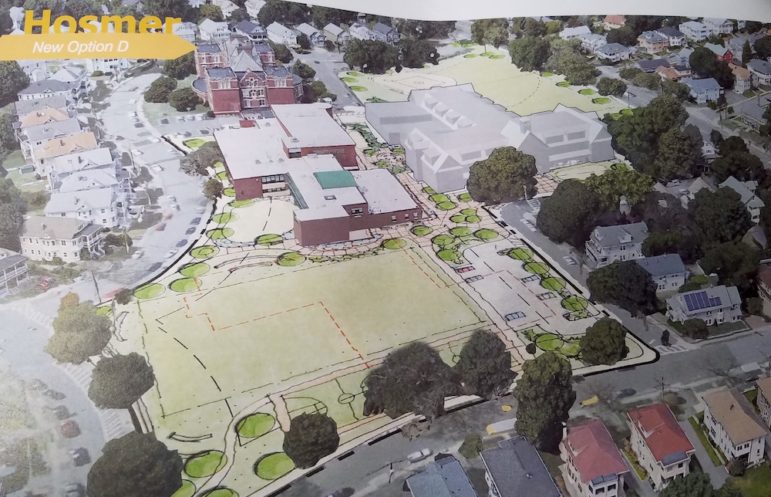
Ai3
A view of the conceptual design of Hosmer Elementary School, in grey. It is proposed to have mansard roofs and dormers. Part of the old school (dotted red line) will be torn down, but the 2002 connector and the auditorium/gym will remain.
Details of what Watertown’s three elementary schools will look like after they are renovated came more into focus Thursday when the School Building Committee approved the conceptual designs for Hosmer, Cunniff and Lowell elementary schools.
With the approval, the architects from Ai3 will move onto the schematic design phase of the project. The conceptual designs provide a guide for where designers will put new additions and which areas will be renovated inside the existing buildings, said Scott Dunlap, principal of Ai3. He added, however, that architects are still “pushing and pulling” the floor plans inside the buildings.
Thursday’s meeting began with a walk through of the Hosmer site, where Ai3 had staked out the corners of the proposed new school building that would be built in front of the building with the auditorium and gym, ask you look from Mt. Auburn Street. The building would cover what is now the playground, basketball courts, and part of the playing field.
The concept for the new building changed from the last time the School Building saw the plan.
“When we were talking conceptually we just had an ‘L’ (shaped building),” Dunlap said. “When we started to look at it more closely it made more sense to make it orthogonal [with right angles] to Mt. Auburn Street.”
The new building will have three stories, Dunlap added, and the current design would have mansard roofs and dormers on the top floor.
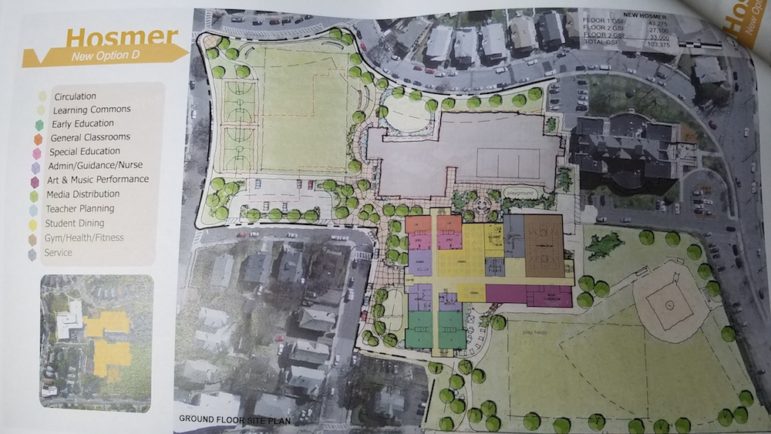
Ai3
An overhead view of the conceptual design of Hosmer School.
The older school building on the east end of the Hosmer campus will be torn down. Demolition will wait, however, because the plan is, during the construction at the other elementary schools (and possibly Watertown High School), to have students move in while their schools are renovated. A playing field will go in the spot whee the building now stands.
The 2002 addition (which connects the old section of the school to the auditorium), and the section with the auditorium, gym and cafeteria will remain. The plan is to house the district’s preschool and pre-kindergarten programs in the remaining section of the Hosmer. Or it could be demolished, if the Town decides to do so.
Before the vote, School Committee Chairman John Portz said he felt uneasy about the plan for Hosmer.
“The Hosmer, when I look at (the plan), makes me nervous,” Portz said. “I find it an awkward building with the existing building (with the auditorium, etc.). Also, do we keep it? Do we not keep it? We are not sure.”
He added that he did not think the design of the new building fits with either the part of Hosmer that will remain, nor the nearby Brigham House, the former Watertown High School and East Junior High.
Ai3’s Jeffrey Levy said that with the mansards and dormers the new building is designed to fit in with the surrounding homes, rather than the other school buildings.
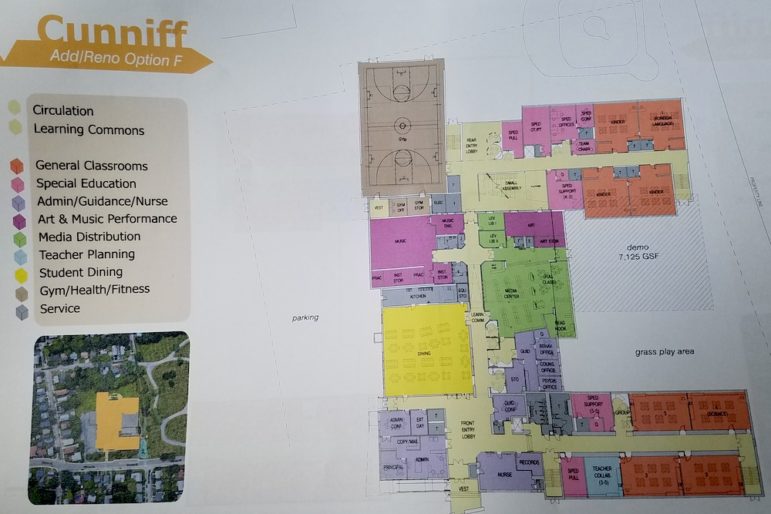
Ai3
A floor plan for Cunniff Elementary School showing the conceptual design of the renovated and expanded school.
Dunlap said the choice to keep the auditorium building and turn it into a preschool/pre-K center was a financial one. The cost of the project is a concern after preliminary cost estimates came in up to $60 million above the $120 million committed by Town Manager Michael Driscoll for the project. He said the Town could afford to borrow that amount without raising taxes with a Proposition 2 1/2 debt exclusion.
The current plan is to renovate the old building, including putting on a new roof, for approximately $3 million, Dunlap said. Some of the space would have to be reconfigured to make preschool and pre-K classrooms.
“To replace that space, it would cost $18 million to $20 million,” Dunlap said.
School Committee member Lindsay Mosca said that other options have been explored, but the spot where it is proposed makes the most sense. Other locations would have blocked the view of historic Brigham House, or required a long driveway off Mt. Auburn Street that would cut through what is now playing fields.
Town Council President Mark Sideris, who is also a School Committee member, said he shares some of Portz’s concerns.
“I’m as hesitant as you,” Sideris said. “Not just about Hosmer, but Cunniff and Lowell, too. When you put in a large addition it is a challenge.”
Sideris said, however, that architects need to have a direction so they can start schematic designs, during which the details of the layout and scope of work at each school will be decided. The School Building Committee gave Ai3 the go ahead on the conceptual plans.
The Committee looked at two options for Cunniff. Both had a large addition on the south side of the property (farthest from Warren Street). In one the addition was angled so that there was more open space between the two wings of the building. The other was straighter, and was parallel to the existing wing (which includes the front entrance).
The new addition will cut down the amount of space on the playing field, and the committee worried about losing the tee ball field behind Cunniff. Dunlap said he believes a field can be fit on the remaining space if the straight addition is used.
The School Building Committee selected the straight addition.
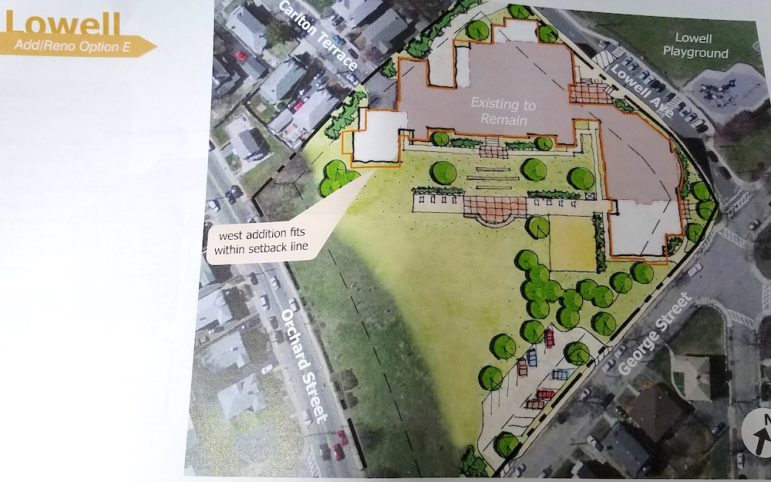
Ai3
An overhead view of the conceptual design of Lowell School. The orange lines show the latest proposal for the new additions.
At the Lowell, small, three story additions of classrooms are planned on either end of the existing building, along with expansion of the cafeteria and the addition of a multipurpose room next to the gym.
The exact shapes of the classroom additions have not been decided, Dunlap said. Both sit close to the property lines.
Members of the committee suggested that the sidewalk be bumped out into George Street, which would give a bit more room on the site, and calm traffic in the area. Town Council Vice President Vincent Piccirilli said the area could also use granite curbs.
“George Street is the only street bordering a school that doesn’t have a curb,” Piccirilli said. “When the project is done, it probably will need to be repaved. I suggest under Complete Streets we put in curbing, and neck down and have bump outs on George Street.”
The next School Building Committee meeting will be on July 11 in Town Hall. Architects will present its latest designs.
Hosmer Proposed as Swing Space During School Construction Projects
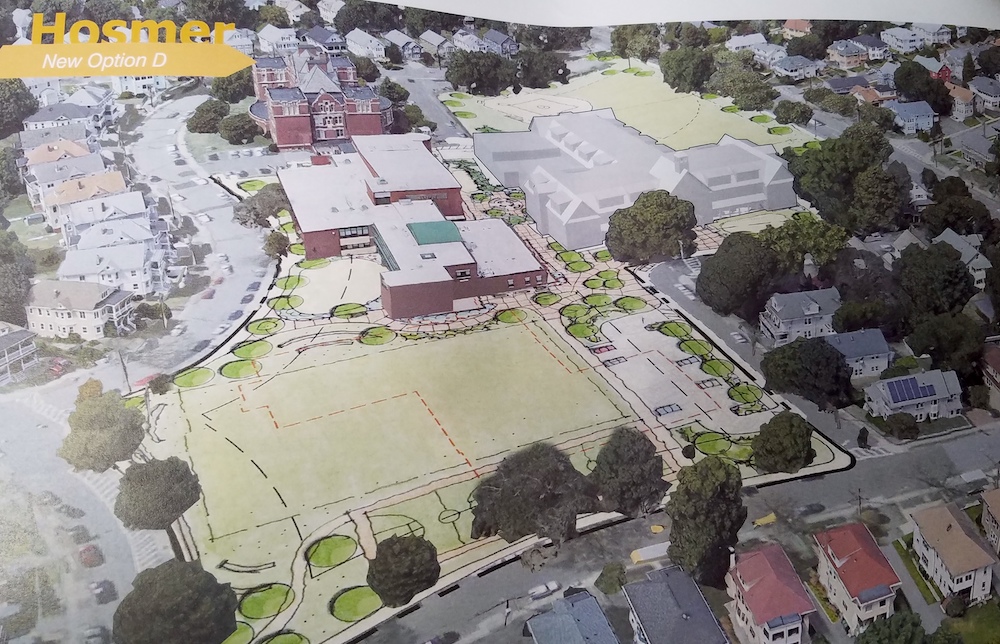
Really , bump out George St ? Why , so it will make it more dangerous than it already is with teachers and parents parking on both sides ? So all of us who live on the abutting streets will need to drive a smart car to fit through ? Oh and if a fire truck doesn’t fit now , how will it fit then ? What about the intersection at George , Walcott / Mason ? Will the police continue to let people park up on the corners of the sidewalk ? Seriously , maybe I just read this article wrong , I really hope so !
I think you are reading it right. The area they are talking about is right near the corner of the school, where there is also an intersection with Lowell and Walcott. They said the pavement is very wide in that spot. See a map here:
https://www.google.com/maps/place/George+St,+Watertown,+MA+02472/@42.3768133,-71.1847811,17z/data=!3m1!4b1!4m5!3m4!1s0x89e377f9bb6600c9:0x4aceecf5a5e1d3fc!8m2!3d42.3768133!4d-71.1825924
I believe the architect stated a study of that intersection would need to be done before ant changes would be put forth here.
Also, I don’t think changes to the roadway can be dictated by the architect or the School Department. It would have to come from the Town.
Regarding the Lowell School, I am surprised that on site parking is no being fully addressed.
One of the first priorities should be adding additional drop off and go areas like along Orchard St. where a cut in would allow several cars to pull in drop off and go.
Like what you see in front of Star Market on Mt. Auburn St.
Also bike areas.
Can some one point out where the study that shows it is desirable to build a new addition to Hosmer and tear down the older addition. I could not find anything on the web site explaining that decision. The SMMA study does not suggest this decision.
I believe that this change was proposed in order to save several millions of $$. They will use the old section(Z building) as swing space for both the Cunniff/Lowell. I’m not 100% but I believe this was the largest impetus.
Still looking for the study that explains the decision to tear down the older section of Hosmer and build a new addition. It can’t be to save money.